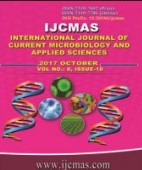


 National Academy of Agricultural Sciences (NAAS)
National Academy of Agricultural Sciences (NAAS)

|
PRINT ISSN : 2319-7692
Online ISSN : 2319-7706 Issues : 12 per year Publisher : Excellent Publishers Email : editorijcmas@gmail.com / submit@ijcmas.com Editor-in-chief: Dr.M.Prakash Index Copernicus ICV 2018: 95.39 NAAS RATING 2020: 5.38 |
The diamondback moth, Plutella xylostella (L.) (Lepidoptera: Yponomeutidae), is cosmopolitan in its geographical distribution, occurring in all major crucifer growing regions of world. The larva skeletonize the leaves and ultimately affecting the plant growth and rendering it unfit for further use. Since the science changes with topographical source, hereditary strategies, for example, the relative rate of regular choice and hereditary separation ought to be utilized to investigate the geological variation of diamondback moth. Fertility table summarizes the information on biological performance of a species. The analysis revealed the variation among four populations of P. xylostella. Saharanpur population had maximum intrinsic rate of increase rm, followed by Pantnagar and Delhi whereas, the least value of rm was observed in the Hisar population. On comparing fertility parameters of different populations, it was found that the Theog population was the most prolific among all the populations while the Hisar population was the least amongst all the populations.
 |
 |
 |
 |
 |